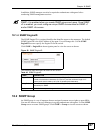
Chapter 18 SNMP
ES-1552 User’s Guide
106
SNMP itself is a simple request/response protocol based on the manager/agent model. The
manager issues a request and the agent returns responses using the following protocol
operations:
18.1.1 Supported MIBs
MIBs let administrators collect statistics and monitor status and performance.
The switch supports the following MIBs:
• RFC 1213 SNMP MIB II
• MIB II - System
• MIB II - Interface
• RFC 1398 MIB - Ether-like
• RFC 2674 SNMPv2, SNMPv2c
• RFC 2819 RMON
• Group 1 (Statistics)
• Group 2 (History)
• Group 3 (Alarm)
• Group 9 (Event)
18.1.2 SNMP Traps
The switch sends traps to an SNMP manager when an event occurs. SNMP traps supported are
outlined in the following table.
18.1.3 SNMP v3 and Authentication
SNMP v3 adds the concept of groups and users to enhance security for SNMP management. A
user is an SNMP manager. A group is a group of SNMP managers that are assigned common
access rights to MIBs. For example, one group of managers may only have access to agents
with MIB II - System Group MIBs while another may have access to agents with the Ether-
like MIB.
Table 38 SNMP Commands
COMMAND DESCRIPTION
Get Allows the manager to retrieve an object variable from the agent.
GetNext Allows the manager to retrieve the next object variable from a table or list within an
agent. In SNMPv1, when a manager wants to retrieve all elements of a table from an
agent, it initiates a Get operation, followed by a series of GetNext operations.
Set Allows the manager to set values for object variables within an agent.
Trap Used by the agent to inform the manager of some events.
Table 39 SNMP Traps
OBJECT LABEL OBJECT ID DESCRIPTION
SNMPv1/SNMPv2 Trap/Inform Requests:
authenticationFailure 1.3.6.1.6.3.1.1.5.5 This trap is sent when an SNMP request comes from
non-authenticated hosts.
RFC2819 Traps (alarmEntry) 1.3.6.1.2.1.16.3.1.1 A RMON event has been triggered.


















